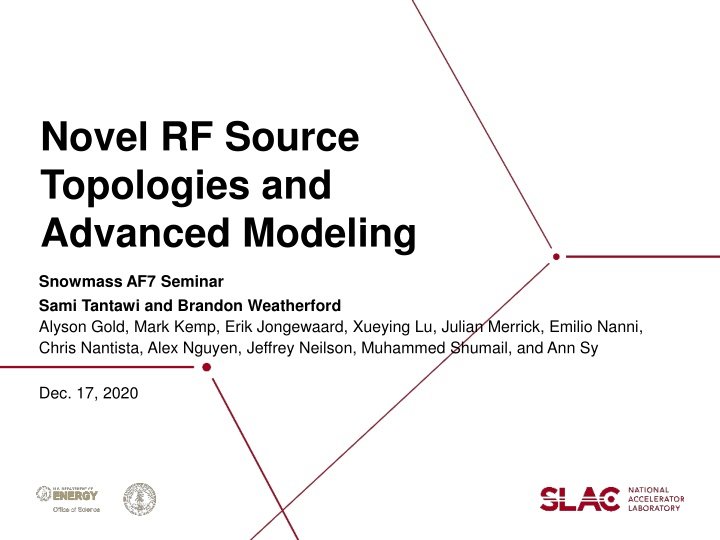Innovations in RF Source Topologies and Modeling for Enhanced Efficiency
Explore novel RF source topologies and advanced modeling techniques to achieve higher efficiency and power density in RF systems. Discover tradeoffs, multi-beam arrays, radial beam klystrons, and deflected beam amplifiers for improved performance in high-power applications.
Download Presentation

Please find below an Image/Link to download the presentation.
The content on the website is provided AS IS for your information and personal use only. It may not be sold, licensed, or shared on other websites without obtaining consent from the author.If you encounter any issues during the download, it is possible that the publisher has removed the file from their server.
You are allowed to download the files provided on this website for personal or commercial use, subject to the condition that they are used lawfully. All files are the property of their respective owners.
The content on the website is provided AS IS for your information and personal use only. It may not be sold, licensed, or shared on other websites without obtaining consent from the author.
E N D
Presentation Transcript
Novel RF Source Topologies and Advanced Modeling Snowmass AF7 Seminar Sami Tantawi and Brandon Weatherford Alyson Gold, Mark Kemp, Erik Jongewaard, Xueying Lu, Julian Merrick, Emilio Nanni, Chris Nantista, Alex Nguyen, Jeffrey Neilson, Muhammed Shumail, and Ann Sy Dec. 17, 2020
The Main Tradeoff Efficiency Versus Power Density In conventional klystrons, efficiency decreases almost linearly with perveance At fixed voltage, efficiency ~ 1/power density Efficiency decreases due to space charge de-bunching & energy spread in beam For orders of magnitude improvement in $/kW, we have to break this scaling S. Simrock & M. Grecki, 5th LC School, Switzerland, 2010, LLRF & HPRF New RF sources are needed for high perveance AND high efficiency Multi-beam arrays: power combining for higher total perveance Radial beams: lower charge density w/ minimal focusing Trajectory modulation: mono-energetic beams for high efficiency
Multi-beam Klystrino Arrays with Floquet Combiner Scaling to MW-levels is achieved using power combined klystrino subassembly arrays Passive power combining via 16-power waveguide matrix Single vacuum envelope for several beams Shared high voltage insulators Common beam dump and cooling Floquet output combiner 16 Klystrinos 3
The Radial Beam Klystron Concept Has High Beam Power In a Compact Array Simulations show that the radial klystron is a naturally stable device Phasespace Graded PPM Focusing magnets 250 200 R (mm) 0.05 T peak on axis field Minimal focusing required due to low current density Order of magnitude less axial field than a typical RF device 150 100 50 0 -2 -1 0 1 2 Z (mm) On-axis radial magnetic field RBK module Low profile configuration ideal for compact, high power arrays Extraction waveguide(s) 1 6 2 3... n Output combined using similar technology as MBK M. Dal Forno,et. al, Design of a radial klystron , IPAC 2015. Forno, M. Dal, S. G. Tantawi, R. D. Ruth, and A. Jensen, Progress on Design of Radial Klystrons, IVEC, 2016 4 Franzi, Tantawi, Dal Forno, Gold
The Deflected Beam Amplifier Will Achieve High Efficiencies By Circumventing Traditional Bunching Schemes Multi-cell output structure Aberration correction with an electrostatic deflector Very high efficiency (>85%) No traditional bunching required Low thermal loading <5 % power in spent beam CL Franzi, Matt, Aaron Jensen, Sami Tantawi, Filippos Toufexis, and Alysson Vrielink, The Distributed Bunch Amplifier, IPAC, 2016 5
Deflected Beam Frequency Multiplier Provides a Path Towards mm-Wave/ THz Frequencies Phase synchronous deflected beam interaction with harmonic whispering gallery mode Electron beam continuously interacts with decelerating phase of RF No traditional bunching of beam Successful LDRD technology that has advanced to the GARD portfolio Low beam voltage and low cavity voltage allow for higher frequency operation Toufexis, et al Applied Physics Letters 110.26 (2017): 263507. Toufexis, PhD Dissertation (2018) 6 Toufexis, Tantawi
Modeling Requirements for RF Source Development Novel RF sources present a formidable modeling challenge. Strong image charges and currents on walls Boundary conditions cannot be neglected Moderately relativistic beam No asymptotic assumptions (?~0 or?~1) Fields generated by beam act back on beam Nonlinear problem 7
Accurate Modeling of Exotic RF Sources is Impossible with Existing Simulation Tools Without generalized codes that can model complex topologies, we need to assume a spherical cow 8
Multi-scale Simulations are Slow and Costly Transient Solvers: The Wrong Tool at Steady-State RF sources are multi-scale (spatially and temporally) Simulations can take days to run, even on high performance clusters Example of time-scales relevant to gyrotron operation (Thesis, Braunmuller 2016) 9
Lagrangian Field Theory Reformulation of Maxwell s equations ? ? =? ? ? = 0 ? 1 ?2??? + ? ? ? ? = ? ? = ??? 2 ?2? ? 2 ?? + ? ????? = 0 ? 2?? + ?? ? ? ? 10
Lagrangian EM Solver Theory Lorentz-independent Gauge fixing term Addition of the Gauge fixing term Splitting of , A in the Lagrangian Problem can be described with nodal (instead of vector) basis functions This approach yields a simpler solution and very fast code for simulations, including beam loading and space charge effects 11
Lagrangian EM Solver Theory, contd. ??? ? = ???+ ?? ?






















